A Mixed Methods Longitudinal Investigation of Maternal Depression Across the Perinatal Period Among Mothers Who Gave Birth During the COVID-19 Pandemic
IF 2.5
2区 医学
Q2 PUBLIC, ENVIRONMENTAL & OCCUPATIONAL HEALTH
引用次数: 0
Abstract
Background
Depression during the perinatal period is associated with negative outcomes for both mothers and children, including higher rates of chronic depression in mothers and physical, emotional, and cognitive issues in children. This study aimed to determine how the stressors of the COVID-19 pandemic contributed to prenatal and postpartum depressive symptoms among a sample of peripartum mothers who gave birth during the pandemic. This study also examined risk factors for postpartum depression, including prenatal depressive symptoms, demographic characteristics, timing of birth during the pandemic, pregnancy intention, birth expectations and experiences, and pandemic-related concerns.
Methods
This mixed methods study included data from online surveys using a convenience sample of 284 expectant mothers with due dates from April 2020 to September 2021, and qualitative interviews with a subset of participants. Depressive symptoms and risk for clinical depression were assessed using the Edinburgh Postnatal Depression Scale during the third trimester of pregnancy and again within 8 weeks postpartum. Multiple regression models examined potential risk factors to determine which variables most predicted participants’ postpartum depressive symptoms and risk of clinical depression.
Results
Among this nonrepresentative, mostly white, and highly resourced sample, one-third of participants (33.8%) met the criteria for risk of clinical depression during the prenatal period, and 32.7% met this threshold in the postpartum period. Participants who reported higher levels of prenatal depressive symptoms, gave birth earlier in the pandemic, reported lower income, or had more pandemic-related concerns tended to report more postpartum depressive symptoms, adjusting for demographic characteristics and other variables of interest. Peripartum mothers who reported symptoms consistent with risk of clinical depression prenatally were almost four times more likely to screen positive for depression in the postpartum period, even after adjusting for other variables. In interviews, participants attributed negative emotions in pregnancy to uncertainty related to pandemic-related changes in care and expressed grief about missed pregnancy and postpartum experiences. In the postpartum period, some participants reported that their births were ultimately less stressful than anticipated.
Conclusions
Findings highlight the need for consistent and frequent depression screenings across the perinatal period, especially among participants who report depressive symptoms prenatally. Participants who gave birth early in the pandemic were at the highest risk of postpartum depression and may continue to need additional supports.
在 COVID-19 大流行期间分娩的母亲在围产期抑郁情况的混合方法纵向调查。
背景:围产期抑郁症对母亲和孩子都有负面影响,包括母亲患慢性抑郁症的比例较高,孩子出现身体、情绪和认知问题的比例较高。本研究旨在确定 COVID-19 大流行带来的压力如何导致在大流行期间分娩的围产期母亲出现产前和产后抑郁症状。本研究还考察了产后抑郁症的风险因素,包括产前抑郁症状、人口统计学特征、大流行期间的分娩时间、怀孕意愿、分娩期望和经历以及与大流行相关的担忧:这项混合方法研究包括对预产期为 2020 年 4 月至 2021 年 9 月的 284 名准妈妈进行在线调查,以及对部分参与者进行定性访谈。研究人员使用爱丁堡产后抑郁量表(Edinburgh Postnatal Depression Scale)对怀孕三个月和产后 8 周内的抑郁症状和临床抑郁风险进行了评估。多元回归模型研究了潜在的风险因素,以确定哪些变量最能预测参与者的产后抑郁症状和临床抑郁症风险:在这个无代表性、以白人为主、资源丰富的样本中,三分之一的参与者(33.8%)在产前符合临床抑郁风险标准,32.7%的参与者在产后符合这一标准。在控制人口统计学特征和其他相关变量的情况下,产前抑郁症状程度较高、在大流行期间较早分娩、收入较低或有更多与大流行相关担忧的参与者往往会报告更多的产后抑郁症状。即使在控制了其他变量的情况下,产前报告了与临床抑郁症风险相符症状的围产期母亲在产后抑郁症筛查中呈阳性的可能性几乎是对照组的四倍。在访谈中,参与者将孕期的负面情绪归因于与大流行病相关的护理变化所带来的不确定性,并对错过的孕期和产后经历表示悲伤。在产后,一些参与者表示他们的分娩最终比预期的压力要小:研究结果凸显了在围产期进行持续、频繁的抑郁筛查的必要性,尤其是在产前报告有抑郁症状的参与者中。在大流行早期分娩的参与者患产后抑郁症的风险最高,可能仍需要额外的支持。
本文章由计算机程序翻译,如有差异,请以英文原文为准。
求助全文
约1分钟内获得全文
求助全文
来源期刊

Womens Health Issues
Multiple-
CiteScore
4.50
自引率
6.20%
发文量
97
审稿时长
32 days
期刊介绍:
Women"s Health Issues (WHI) is a peer-reviewed, bimonthly, multidisciplinary journal that publishes research and review manuscripts related to women"s health care and policy. As the official journal of the Jacobs Institute of Women"s Health, it is dedicated to improving the health and health care of all women throughout the lifespan and in diverse communities. The journal seeks to inform health services researchers, health care and public health professionals, social scientists, policymakers, and others concerned with women"s health.
 求助内容:
求助内容: 应助结果提醒方式:
应助结果提醒方式:


